Video of the Week:
Flower Bed Design
Upcoming Events:

February 4, 2016
Manhattan, KS
Grow Your Garden Center Business in 2016! We hope you'll join us for this companion conference to the biennial
NurseryWorks conference--RetailWorks on Thursday, February 4, 2016 in Manhattan. While NurseryWorks focuses on providing resources for wholesale nursery crop growers, RetailWorks is designed with the independent garden center's needs in mind. We continue to bring in outstanding national and local speakers on a variety of topics. You'll
find great content and networking at RetailWorks 2016--get it on your calendar and register today! For more information, go to:
http://retailworks.weebly.com/ or register online at
https://2016retailworks.eventbrite.com
Fruit:
Fruit Trees and Frost
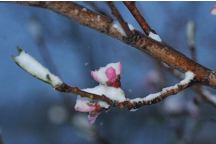
Apricots are more likely to have frost kill flowers than peaches because they bloom a bit earlier. Though there are late-blooming apricot varieties, the differences between full bloom on early and late-blooming varieties appears to be slight. Research at Virginia Tech in the 90's showed a maximum of a 4-day difference between early and late varieties. However, in some years that may be all that is needed. The trees in the study that were considered late blooming
included Hungarian Rose, Tilton and Harlayne. Harglow was not included in the study but is also considered late-blooming. See https://pubs.ext.vt.edu/422/422-761/422-761.html for more info.
Peaches are next on the list for being likely to be caught by a late frost. With peaches, two characteristics become important when considering whether they will be damaged by late frosts. Like apricots, bloom time is very important but fruit bud hardiness should also be considered. In this case, fruit bud hardiness refers to hardiness to late frosts rather than the ability to survive extreme low temperatures during the winter. Late bloomers included ‘China Pearl’, ‘Encore’, ‘Intrepid’, and ‘Risingstar.’ See http://aces.nmsu.edu/pubs/research/horticulture/RR782.pdf . The ‘Intrepid’ cultivar also has shown excellent cold hardiness when in flower. See http://www.google.com/patents/USPP12357
So, are there other considerations when looking at possible frost damage? Location can be very important. Planting on a hill which allows cold air to drain to lower elevations can help. Also, a location in town will be more likely to have a warmer micro-climate than an exposed location. Some gardeners will add a heat source under a tree during cold nights if they are close to a building. Heat lamps and charcoal briquettes are sometimes used but safety should be the first consideration. (Ward Upham)
Ornamentals:
Dutch Elm Disease Resistant American Elms
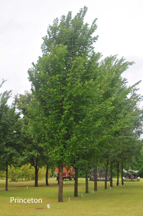
The four true American elms are ‘Valley Forge’, ‘Princeton’, ‘New Harmony’ and ‘Lewis and Clark’ (Prairie Expedition). All have shown excellent tolerance to DED. Characteristics listed below are primarily from our study at the John C. Pair Horticultural Center but storm breakage is from the University of Minnesota. See http://www.extension.umn.edu/environment/agroforestry/elm-trees.html for the Minnesota study.
‘Valley Forge’
Survival: 100%
Crown Shape: Vase
Lacebug damage to foliage: Minimal
European elm flea weevil damage: Minimal
Storm Breakage: Fair
Comments: Strong grower, broad spreading
‘Princeton’
Survival: 100%
Crown Shape: Vase
Lacebug damage to foliage: Minimal
European elm flea weevil damage: Minimal
Storm Breakage: Fair
Comments: Impressive grower, upright habit, attractive tree
‘New Harmony’
Survival: 100%
Crown Shape: Vase and round
Lacebug damage to foliage: Significant
European elm flea weevil damage: Minimal
Storm Breakage: Not in Minnesota study
Comments: Narrow, upright habit with strong, central axis
‘Lews and Clark’ (Prairie Expedition)
Survival: 80%
Crown Shape: Broad oval
Lacebug damage to foliage: Minimal
European elm flea weevil damage: Minimal
Storm Breakage: Good
Comments: Strong grower with broad spreading habit, some wetwood.
Storm damage can be minimized by pruning when the tree is young. Maintain a central leader but prune out all lower branches as the tree grows and branches increase in diameter so that there is room to work under the tree. Also prune out branches attached with a narrow angle as these are most likely to give way in ice or wind storms.
For photos and more information from our John C. Pair Horticultural Center, see
http://webdoc.agsci.colostate.edu/bspm/Kansas%20Elm%20Trial%20Nov%2012%202014.pdf
(Ward Upham)
Start Trees Off Right
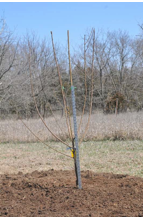
1. Bare soil maintained with herbicides.
2. Area under tree mulched 3 inches deep.
3. Tall fescue allowed to grow under tree.
4. Bermudagrass allowed to grow under tree.
5. Kentucky bluegrass allowed to grow under tree.
All treatments were applied to Eastern redbud seedlings as well as to pecan seedlings. All trees were fertilized according to recommendations and watered during the growing season with up to 1 inch of water if rainfall was deficient. At the end of two years, trees were measured and harvested. Data was taken on caliper (diameter) 6 inches above the ground, weight of aboveground portions of the tree, leaf area, and leaf weight. There were no differences in any measure between the mulched treatment and the bare soil treatment for either tree species. All measures showed significant growth increases if lawn grasses were controlled around the tree.
Results include the following:
1. Caliper: Caliper measures 6 inches above the soil surface were twice as large for plots without grass than for those with either fescue or bluegrass, but only 50% larger when compared to the bermudagrass plots.
2. Top growth weight: Redbuds showed a 300% weight advantage for plots with grasses controlled than those without. Pecans showed a significant 200% increase.
3. Leaf area and leaf weight: Leaf areas were 200% larger in plots without grass competition and leaf weight showed a 300% increase.
The obvious conclusion from this study is that grasses must be controlled under a newly transplanted tree to get the best possible growth. Though there were no differences in growth whether mulch was used or not, you may still wish to mulch for aesthetic reasons or to help control weed growth. How far from the trunk should the grasses be controlled? Try a minimum of 3 feet. (Ward Upham)
Pawpaw Trees: A Native Fruit
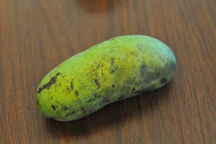
Pawpaw prefers a well-drained, moderately acid (pH 5.5 to 7.0), moist soil and high organic matter content. Organic mulch is also recommended. Irrigation will be helpful to necessary depending on what part of Kansas they are grown.
In the wild, the pawpaw is an understory tree and may do better with partial shade, especially during the first 2 to 3 years. Protection from high winds is also advisable due to the large leaves. The pawpaw is a small tree that may reach 20 feet high but is less broad. Trees require cross-pollination and so at least 2 and preferably 3 different varieties should be grown. These trees are pollinated by insects other than bees and must be planted close together. Trees should be no further than 30 feet apart in order to insure good pollination.
The soil for planting should be prepared in advance of receiving the trees. Amend the soil with organic matter in the area where the trees will be planted. Do not amend just the soil from the planting hole especially if the soil is heavy and has high clay content. If you do, you have essentially made a pot that will hold water and may drown the tree. Rather add organic matter to the area in which the tree will be planted before digging the planting hole; at least a 10- by 10-foot square. You may want to treat the entire area where your trees will be planted. Add 2 inches of organic matter to the surface of the soil and then till in.
The planting hole should be the same depth as the root system but 2 to 3 times as wide. Pawpaws have fleshy roots and are better planted in the spring (April) rather than fall unless container grown. Container-grown plants can be planted virtually anytime.
Keep newly planted trees well watered. The soil should be moist but not waterlogged. Keep the planting area completely free of weeds or any other type of vegetation within 3 feet of the trees. Mulching is recommended.
There has been a significant amount of work done on pawpaw by Kentucky State University. You can reach their pawpaw site at http://www.pawpaw.kysu.edu/ Information on growing pawpaws is available from Peterson Pawpaws at http://www.petersonpawpaws.com Neil Peterson’s pawpaws are the result of over 25 years of research and have been widely tested. Though Neil no longer sells his varieties directly, he does list a number of nurseries that carry them.
The Kansas Forest Service (www.kansasforests.org) has seedling trees available for sale though I would recommend getting named varieties instead if you wish to plant only a few trees. The fruit from named varieties will be of a higher quality than that from a seedling tree. Named variety pawpaws are available from Stark Brothers
(www.starkbros.com) and one from Raintree Nursery (www.raintreenursery.com).
The University of Missouri has a couple of different pawpaw cultivar trials. You can find results from one of these trials at http://www.centerforagroforestry.org/pubs/pawpaws.pdf (Ward Upham)
Miscellaneous:
Bird Feeding
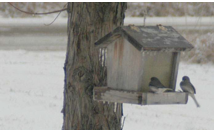
As you become more interested in bird feeding, you may want to use more than one feeder to attract specific species of birds. Following is a list of bird species with the grains they prefer.
- Cardinal, evening grosbeak and most finch species – sunflower seeds, all types.
- Rufous-sided towhee – white proso millet.
- Dark-eyed junco – white and red proso millet, canary seed, fine cracked corn.
- Many sparrow species – white and red proso millet.
- Bluejay – peanut kernels and sunflower seeds of all types.
- Chickadee and tufted titmouse – peanut kernels, oil (black) and black-striped sunflower seeds.
- Red-breasted nuthatch – oil (black) and black-striped sunflower seeds.
- Brown thrasher – hulled and black-striped sunflower seeds.
- Red-winged blackbird – white and red proso millet plus German (golden) millet
- Mourning dove – oil (black) sunflower seeds, white and red proso plus German (golden)millet.
Extended cold periods can also make water unavailable. A heated birdbath can be a tremendous draw for birds during times when all other water is frozen. Energy use is usually less than what most people expect IF the heater has a built-in thermostat. If you would like more information, Chuck Otte, Agriculture Extension Agent for Geary County has a series of backyard birding guides at http://gearycountyextension.com/NRMW.htm (Ward Upham)
Growing Your Own Firewood
trees would reduce the time and effort required to supply the wood needed. Actually, storm-damaged trees or trees in the wrong place will always provide a measure of the demand but a significant supply could be supported by a firewood “plantation.” Plant species is an important consideration as not all trees have the same density and therefore, heat
value. The greater the dry weight, the better. The highest value for trees commonly found in Kansas is Osage Orange (Hedgeball tree) at 4,800 pounds per cord. Osage orange has a gnarly growth habit and a nasty set of thorns. This species also sparks which isn’t a problem in a wood-fired boiler but certainly would be in an open fireplace.
Black locust is next with 4,200 pounds per cord. Black locust is a fast grower and also has excellent burning qualities and makes a nice bed of coals. However, it is hard to split, suckers, and has some relatively small thorns, especially on young trees. Bur oak and red oak come in at 3,800 and 3,500 pounds per cord respectively but are not fast growers. Mulberry, however, has the same weight as red oak but grows more quickly. Silver maple has less heat value (3,000 pounds per cord) but is a very fast growing tree.
Black locust would be my first choice for this purpose though you may wish to plant rows of several species. However, each situation is different and another species may work better for you. So how do you set out your plantation? Dr. Wayne Geyer, one of our retired forestry professors, has done many woody biomass studies over the past 35 years. Following are some recommendations that have come out of his studies.
- Plant locust a few rows in from a field edge to reduce suckering in the field.
- Plant on a close spacing, 4 to 6 feet apart. This maximizes yield and reduces side branching.
- Control weeds the first two years.
- Harvest every 5 years, most trees will resprout and can be reharvested.
- Plant about 1 acre per year for 5 years if you wish to supply the majority of the firewood needed to heat your home.
Trees mentioned above and available from the Kansas Forest Service include osage orange, bur oak, red oak and silver maple. (Ward Upham)
Contributors: Ward Upham, Extension Associate
 RSS Feed
RSS Feed
